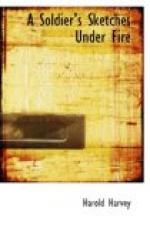[Illustration: Map: La Bassee-St. Julien]
We reached Armentieres (relieving the Leinster Regiment and the 9th Lancers in the first line trenches, distant from the first line German trenches 30 yards) at a critical time.
The effort in progress was to straighten out our line so as to get it level with Ypres, and the whole position all around was a very perilous one. We were short of men—very short—and had practically no reserves. Almost every available man had to do the work and duty of three. For a month or so almost all the heavy work fell upon the line regiments, we doing the wiring, digging, and the usual work of the Royal Engineers, the number of these being relatively scanty indeed.
There was also some shortage of shells and ammunition for guns and rifles, while of trench mortars a division had but few. We had to make our own bombs out of jam tins. These were charged and stuck down, a detonator being inserted, and we crawled out with them at night and heaved them into the German trenches. We had to time each heave with the most extreme accuracy, for the fraction of a moment too late meant the bursting of the bomb in our hands. The game we played with the Huns (keeping up a continuous fire all night, for instance) was one of pure bluff. They were massed in, we estimated, four army corps, and could have walked through us—if they had only known.
As my illustrations do not follow all the movements of my detachment, I will say here that from Armentieres we were shifted to Houplines, about 4-1/2 to 5 miles north-east, where we made an advance of a hundred yards or so to straighten up. From Houplines we were moved south to La Bassee, and from La Bassee to Neuve Chapelle (where our 3rd Battalion was almost wiped out in the indecisive victory that proved much and won little), and then back to Armentieres, whence we were sent north to St. Eloi, after making a short advance in the vicinity of Messines. From St. Eloi we were ordered to Hill 60, taking part in the now historic battle there. After Hill 60, Ypres, where shrapnel and poison gas put an end to my soldiering days—I am afraid for ever.
To come back to our first arrival at Armentieres, our position was in touch with a small village not marked on the map, in the direction of Houplines. This village, which became almost wholly destroyed, had been knocked about by the enemy fire, but the tall chimney of a distillery had been spared, no doubt because the Germans wanted it themselves, intact. However much they wished, and often and hard as they tried, to take it—especially as from it could be conned not only our lines but the lay of the surrounding country—they never did take it, and it never fell, though it was hit in two places and cracked.
At 10.30 one morning I crawled over the parapet—that is, the sandbags—of our trench to sketch the picture of which this distillery shaft is the central feature. The trench also near the middle we had dug overnight for communication purposes. The enemy were to the left of the buildings shown, and our own men were occupying the position to the right of the chimney at a range of 250 yards.




